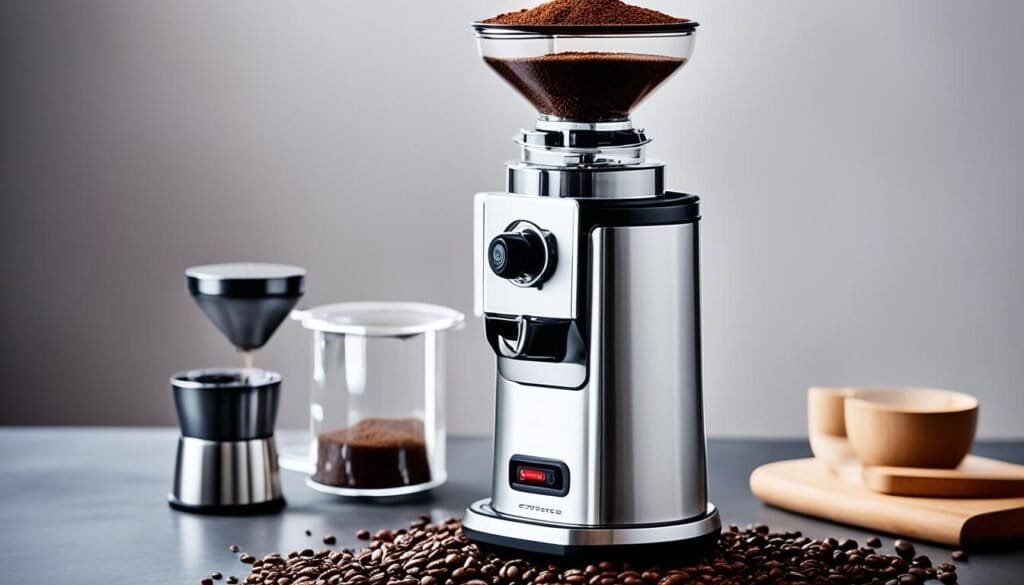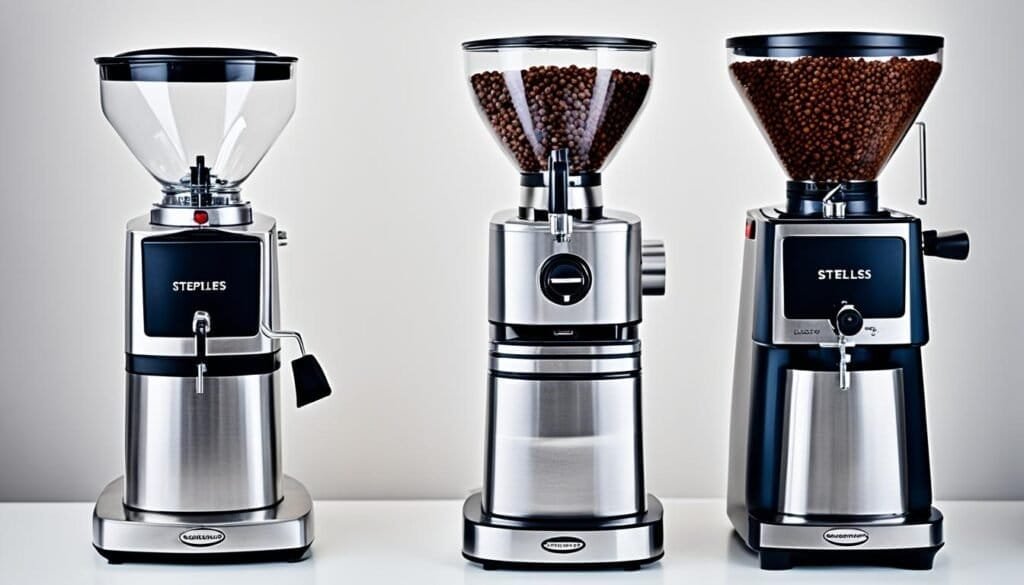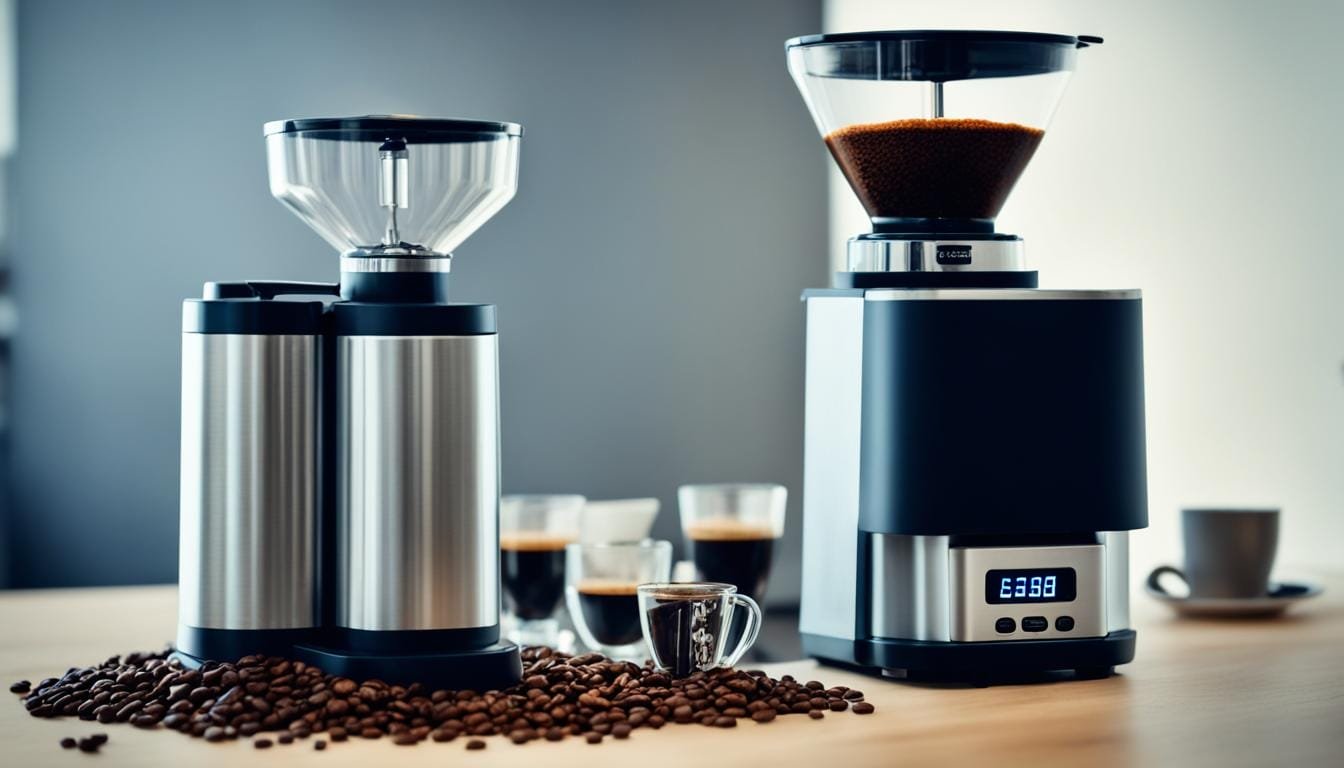Welcome to the Ultimate Guide to Advanced Coffee Grinders, where we dive deep into the world of premium coffee grinders and help you choose the best one for your brewing needs. With so many options available, selecting the right coffee grinder can be overwhelming. But fear not, because we’ve got you covered.
Whether you’re a coffee connoisseur or just starting your journey into the world of coffee, this guide will provide you with expert reviews, detailed comparisons, and essential tips to help you make an informed decision. We’ll explore the different types of coffee grinders, the importance of grind size, and the factors to consider when buying an advanced coffee grinder.
Key Takeaways:
- Choosing the right coffee grinder is essential for brewing the perfect cup of coffee.
- There are two main types of coffee grinders: blade grinders and burr grinders.
- Grind size plays a crucial role in achieving the best flavor and aroma.
- Factors like burrs material, body material, and hopper capacity should be considered when buying an advanced coffee grinder.
- There are pros and cons to electric and manual coffee grinders.
Types of Coffee Grinders: Blade vs. Burr
When it comes to coffee grinders, there are two main types: blade grinders and burr grinders. Let’s take a closer look at each type to help you understand the key differences and make an informed decision for your coffee brewing needs.
Blade Coffee Grinders
Blade coffee grinders are the most basic and budget-friendly option. They operate by using a spinning blade to chop the coffee beans into smaller pieces. However, the grind size tends to be inconsistent due to the blades’ spinning action, resulting in some beans being finely ground while others remain coarsely ground.
Blade coffee grinders are an affordable choice for casual coffee drinkers who are not overly concerned about the consistency of their coffee grounds.
Burr Coffee Grinders
On the other hand, burr coffee grinders offer a more precise and consistent grinding experience. These grinders use two abrasive surfaces, known as burrs, to crush the coffee beans into a uniform size. The key advantage of burr grinders is their ability to produce consistent grounds, which directly impacts the quality and taste of your coffee.
There are two main types of burr grinders: conical burr grinders and flat burr grinders.
Conical Burr Grinders
Conical burr grinders are highly regarded for preserving the delicate flavors of your coffee beans. The conical shape of the burrs allows for slower and cooler grinding, minimizing heat transfer to the coffee grounds. This results in a smoother and more flavorful cup of coffee.
Flat Burr Grinders
Flat burr grinders, also known as disc grinders, are particularly suitable for drip coffee or French press brewing methods. The flat shape of the burrs produces a consistent grind size, resulting in even extraction during the brewing process.
The choice between blade and burr grinders ultimately depends on your brewing preferences and the quality of coffee you want to achieve. If you prioritize consistency and flavor, investing in a burr grinder, whether conical or flat, is the recommended option.
| Blade Coffee Grinders | Burr Coffee Grinders |
|---|---|
|
|
|
|
Importance of Grind Size in Coffee Brewing
The grind size is a critical factor in the coffee brewing process. Different brewing methods require specific grind sizes to extract the optimum flavors and aromas from the coffee beans. Understanding the ideal grind size for each brewing method is essential for achieving the perfect cup of coffee.
In espresso machines, a fine and consistent grind size is necessary for proper extraction. The compact nature of espresso brewing requires the water to pass through the coffee grounds quickly, extracting intense flavors and creating a thick, concentrated shot of espresso. A fine grind size ensures that the water interacts sufficiently with the coffee particles, allowing for the extraction of the desired flavors.
Drip coffee makers, such as pour-over or drip brewers, require a medium grind size. The water in these brewing methods flows through the coffee grounds more slowly than in espresso brewing. A medium grind size allows the water to extract a balanced flavor profile from the coffee, resulting in a well-rounded and flavorful cup of coffee.
For French press brewing, a coarse grind size is needed. French press brewing involves steeping coffee grounds in hot water for an extended period. The coarse grind size enables the water to extract the desired flavors without over-extraction, producing a full-bodied and robust coffee.
By selecting the appropriate grind size for each brewing method, you can enhance the flavor and aroma of your coffee. Experimenting with different grind sizes allows you to fine-tune your brewing process and discover the perfect balance that suits your taste preferences.
Factors to Consider When Buying an Advanced Coffee Grinder
When purchasing an advanced coffee grinder, there are several key factors to consider that will ensure you make the right choice for your brewing needs. These factors include the material of the burrs, the body material, hopper capacity, bean storage options, noise level, and user-friendliness.
Burrs Material
The material of the burrs has a significant impact on grind consistency and durability. Stainless steel burrs are commonly found in high-quality grinders, offering excellent performance and long-lasting durability. Ceramic and titanium burrs are also popular options, each with their unique advantages and characteristics.
Body Material
The body material of the coffee grinder should be sturdy and preferably made from stainless steel or aluminum. These materials are less likely to affect the flavor of the coffee compared to other materials. Additionally, a robust body ensures the grinder’s longevity and reliability.
Hopper Capacity
Consider the hopper capacity of the coffee grinder based on your consumption needs. If you brew coffee frequently or have multiple coffee drinkers in your household, a grinder with a larger hopper capacity will be more convenient, as it will require fewer refills.
Bean Storage
Opt for a coffee grinder that offers an airtight bean storage container. This feature ensures the freshness and aroma of the coffee beans are preserved, allowing you to enjoy the full flavor profile of your coffee with each cup.
Noise Level
Some coffee grinders can be noisy during operation, which may be a concern, especially if you live in a shared space or have a sensitivity to noise. Consider choosing a grinder with reduced noise levels to minimize disturbances.
User-Friendliness
Look for a coffee grinder that offers user-friendly features, such as intuitive controls and easy maintenance. Features like programmable settings can also enhance convenience and customization options for your coffee brewing experience.
Investing in an advanced coffee grinder with the right combination of burrs material, body material, hopper capacity, bean storage, noise level, and user-friendliness is essential for achieving the best grinding results and enhancing your coffee brewing journey.
| Factors | Considerations |
|---|---|
| Burrs Material | Stainless steel, ceramic, titanium |
| Body Material | Sturdy stainless steel or aluminum |
| Hopper Capacity | Based on consumption needs |
| Bean Storage | Airtight container for freshness |
| Noise Level | Preferably reduced noise operation |
| User-Friendliness | Intuitive controls and easy maintenance |
Electric vs. Manual Coffee Grinders: Pros and Cons
When it comes to coffee grinders, you have two main options: electric and manual. Each type offers its own set of advantages and disadvantages, catering to different preferences and lifestyles.
Electric Coffee Grinders

Electric coffee grinders are perfect for those who value convenience and consistency. They are ideal for busy mornings when you need a quick and effortless grinding experience. With electric grinders, you can enjoy a wide range of grind size options, allowing you to customize the coffee grounds to suit your preferred brewing method. Whether you prefer espresso, drip coffee, or French press, an electric grinder has got you covered.
“Electric coffee grinders offer convenience and consistency, making them ideal for busy mornings.”
Manual Coffee Grinders
If you enjoy a hands-on approach to brewing coffee, manual coffee grinders are worth considering. They offer a more tactile and controlled grinding experience. Manual grinders are also quieter, which can be beneficial if you don’t want to disturb others in the morning. Additionally, manual grinders are portable and travel-friendly, allowing you to enjoy freshly ground coffee wherever you go. However, it’s important to note that manual grinders require more physical effort and may result in less consistent grind sizes compared to their electric counterparts.
“Manual coffee grinders offer hands-on control and a quieter operation.”
Choosing the Right Grinder
The choice between electric and manual coffee grinders ultimately boils down to your personal preferences and lifestyle. Consider the level of convenience, consistency, and control that you prioritize in your coffee brewing routine. Whether you opt for an electric or manual grinder, both can deliver excellent results when paired with high-quality coffee beans.
Comparison Table: Electric vs. Manual Coffee Grinders
| Aspect | Electric Coffee Grinders | Manual Coffee Grinders |
|---|---|---|
| Convenience | High | Moderate |
| Consistency | High | Moderate |
| Grind Size Options | Wide range | Limited |
| Portability | Less portable | Highly portable |
| Noise Level | Can be noisy | Quiet |
| Physical Effort | Minimal | Requires physical effort |
Note: The aspects mentioned above are generalizations and may vary depending on the specific models and brands of coffee grinders.
Stepped vs. Stepless Coffee Grinders: Pros and Cons
When it comes to coffee grinders, there are two main categories: stepped and stepless. Both types have their own advantages and considerations, so let’s take a closer look at each.
Stepped Coffee Grinders
Stepped coffee grinders are equipped with predefined grind size settings, allowing you to easily switch between different brewing methods with the turn of a dial or knob. This feature provides convenience and simplicity, especially for beginners or those who prefer a straightforward approach to coffee grinding. Stepped grinders are often designed with markings or indicators to indicate the grind size settings, making it easier to achieve consistent results.
With stepped coffee grinders, you have the ability to quickly adjust the grind size for various brewing methods, such as espresso, drip coffee, and French press. However, it’s important to note that there may be limitations in terms of the number of grind size options available. Stepped grinders usually offer a finite number of settings, which may not provide the level of precision desired by more experienced coffee enthusiasts looking for fine-tuned control over their grind size.
Stepless Coffee Grinders
Stepless coffee grinders offer infinite grind size adjustments, providing you with the utmost control and precision over your coffee grounds. This allows for more nuanced adjustments to achieve the perfect grind size for a particular brewing method or to experiment with different extraction techniques. Stepless grinders are favored by experienced coffee enthusiasts and professionals who value the ability to fine-tune their grind size to optimize flavor extraction.
While stepless grinders offer unparalleled control, they can be more challenging to use compared to their stepped counterparts. Without predefined settings, finding the ideal grind size may require some experimentation and trial-and-error. Additionally, stepless grinders often lack markings or indicators for grind size adjustments, which can make it more difficult to achieve consistent results.
Overall, the choice between stepped and stepless coffee grinders depends on your personal preferences and the level of control you desire over your grind size. Stepped grinders provide convenience and ease of use, making them suitable for beginners or those who prefer a more straightforward approach. On the other hand, stepless grinders offer unmatched precision and flexibility, catering to the needs of experienced coffee enthusiasts seeking ultimate control over their grind size.

| Stepped Coffee Grinders | Stepless Coffee Grinders |
|---|---|
| Predefined grind size settings | Infinite grind size adjustments |
| Easier to switch between brewing methods | Allows for fine-tuned control |
| User-friendly and suitable for beginners | Preferred by experienced enthusiasts |
| May offer a limited number of grind size options | Requires experimentation to find the ideal grind size |
Tips for Finding Good Whole Beans
To enhance your coffee experience, it’s important to use good quality whole beans. The right beans can make a significant difference in the flavor and aroma of your coffee. Here are some tips to help you find the best whole beans for your brewing needs:
1. Look for Reputable Coffee Bean Brands
Table: Top Coffee Bean Brands
| Brand | Origin | Roast Level |
|---|---|---|
| Blue Bottle Coffee | Various | Medium to Dark |
| Intelligentsia Coffee | Various | Light to Dark |
| Stumptown Coffee Roasters | Various | Light to Dark |
When searching for whole beans, consider trusted coffee bean brands like Blue Bottle Coffee, Intelligentsia Coffee, and Stumptown Coffee Roasters. These brands are known for their commitment to quality and offer a wide range of origins and roast levels to suit different preferences.
2. Subscribe to Coffee Bean Subscription Services
Quote: “Coffee Rank iQ offers a personalized coffee bean subscription service that delivers freshly roasted beans to your doorstep on a regular basis. With their expertly curated selection of beans from top-notch brands, you can discover new flavors and enjoy a convenient coffee experience.” – Coffee Rank iQ
If you’re looking for convenience and variety, consider subscribing to coffee bean subscription services. These services deliver fresh beans regularly, allowing you to explore different brands and flavors without leaving your home. Coffee Rank iQ is a trusted coffee bean subscription service that offers personalized recommendations based on your taste preferences.
3. Read Reviews and Recommendations
Before making a purchase, take the time to read reviews and recommendations from coffee enthusiasts. Online forums and social media groups are great platforms to gather insights from people who have tried different coffee beans. Pay attention to feedback on flavor profiles, roast levels, and brewing recommendations to find beans that align with your taste preferences.
4. Experiment with Different Origins, Roasts, and Flavor Profiles
- Explore beans from different coffee-growing regions to experience unique flavor profiles. From the fruity and floral Ethiopian beans to the rich and chocolaty beans from Colombia, there’s a world of flavors waiting to be discovered.
- Try beans with different roast levels to find your preferred balance between acidity and bitterness. Light roasts accentuate the natural characteristics of the beans, while dark roasts offer a bold and smoky flavor.
- Experiment with different flavor profiles, such as nutty, caramel, or citrus notes, to find the taste that excites your palate the most.
By exploring various origins, roast levels, and flavor profiles, you’ll develop a better understanding of your coffee preferences and be able to craft the perfect brew to suit your taste.
In conclusion, finding good whole beans is essential for a satisfying coffee experience. Look for reputable brands, consider coffee bean subscription services, read reviews and recommendations, and don’t be afraid to experiment with different origins, roasts, and flavor profiles. By following these tips, you’ll be able to elevate your coffee brewing to a whole new level.
Conclusion
Choosing the right advanced coffee grinder is crucial for achieving the perfect cup of coffee. By considering the type of grinder, the importance of grind size, and factors like burrs material, body material, hopper capacity, and user-friendliness, you can make an informed decision.
Decide between electric and manual grinders based on your preferences and lifestyle. Electric grinders offer convenience and consistency, while manual grinders provide hands-on control.
Determine whether stepped or stepless grinders are more suitable for your brewing needs. Stepped grinders offer predefined grind size settings, while stepless grinders allow for more precise adjustments. Choose based on your level of control and brewing preferences.
Lastly, don’t forget to source good quality whole beans to complement your advanced coffee grinder. Look for reputable coffee bean brands or consider subscribing to coffee bean subscription services. Experiment with different origins, roasts, and flavors to discover your favorite brew. With the knowledge gained from this guide, you can elevate your coffee experience to new heights.
FAQ
What is the difference between blade and burr coffee grinders?
Blade grinders are basic and budget-friendly, but they can result in uneven grind sizes. Burr grinders, on the other hand, offer more precise and consistent grinding results.
Which grind size is suitable for different brewing methods?
Espresso machines require a fine grind, drip coffee makers need a medium grind, and French press brewing calls for a coarse grind.
What factors should I consider when buying an advanced coffee grinder?
Consider the burrs material, body material, hopper capacity, bean storage, noise level, and user-friendliness.
Are electric or manual coffee grinders better?
Electric grinders offer convenience and consistency, while manual grinders provide hands-on control and are more portable.
What is the difference between stepped and stepless coffee grinders?
Stepped grinders have predefined grind size settings, while stepless grinders offer infinite grind size adjustments for more precise control.
How can I find good quality whole beans?
Look for reputable coffee bean brands or consider subscribing to coffee bean subscription services for fresh beans. Read reviews and recommendations from coffee enthusiasts to find the best coffee beans for your taste.




